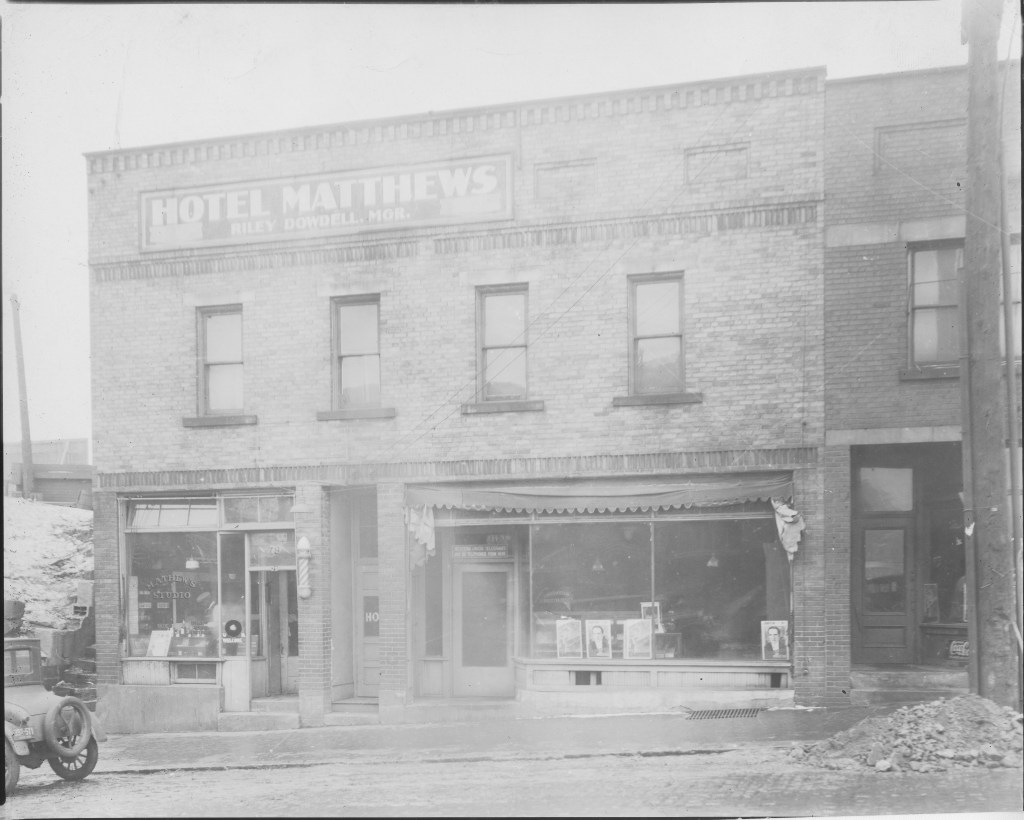George Washington Mathews
George Washington Mathews was the first African American hotel and barber shop owner in Akron.1 His barbershop and hotel were located on North Howard Street at the junction of what is now Howard Street and Martin Luther King, Jr. Blvd. Mathews was one of many successful African American business owners along Howard Street from the1930s to 1960s.2
Born into poverty in Georgia, Mathews stopped in Akron in 1919 on the way home from a boxing match in Toledo, Ohio. Enamored with the booming “Rubber City,” he returned to Akron in 1920 and opened a barbershop. Then, in 1925, Mathews opened the adjoining hotel named Hotel Matthews. The hotel was inexplicably spelled with two T’s, although the owner, Mathews, spelled his name with one T. Speculation is that the spelling of the hotel was an error on the part of the sign makers.3

African American Jazz Culture
During the 1940s, ’50s, and ’60s, Howard Street was the hub of Akron’s African American and jazz culture. Clubs like Benny Rivers, the Cosmopolitan, the Green Turtle, the High Hat, and Tropicana were located there, and routinely featured jazz performances.4 Hotel Matthews was listed in the Negro Travelers’ Green Book as one of three hotels in Akron that were “black-friendly” at the time.5 As one of the few hotels where African American performers were permitted to stay, the hotel became the anchor of the Howard Street district, and the hotel grew to fifty-five rooms. Some of the hotel’s most famous guests included musicians Dizzy Gillespie, Count Basie, Duke Ellington, Louis Armstrong, Cab Calloway, and Ella Fitzgerald.
By 1964, Mathews had reached a level of success few other African American entrepreneurs had. That year, Mathews donated twenty-five thousand dollars to The University of Akron for scholarships. His generous donation was exceptional coming from a man who had not graduated from high school, let alone attended college. His only regret was that he could not double the amount he donated.
Ohio Historical Marker
Hotel Matthews remained open until 1978.6 As the rubber industry in Akron declined, so did the Howard Street District. The hotel, along with many other businesses on Howard Street, were bulldozed in the early ’80s to make way for the Innerbelt Freeway, a project that was part of Akron’s Urban Renewal Movement. George Mathews lived in Akron until he died in 1982, at the age of ninety-five. He was a resident of Akron for sixty-two years.7 An Ohio Historical Marker was placed at the Matthews Hotel location in 2001 to recognize the Howard Street District. It was part of a series of markers placed by the Ohio Bicentennial Commission leading up to Ohio’s bicentennial in 2003. In 2011, a monument was built in remembrance of George Mathews, his hotel, and that culturally-significant era in Akron. The historical marker and monument are located on the northeast corner of North Howard Street and Martin Luther King, Jr. Boulevard.
Hotel Matthews Monument
The Hotel Matthews monument was designed by local artist Miller Horns and features a brick façade with a green door and barbershop pole.8 The monument also features a picture of George Mathews with the quote, “A MONUMENT TO A MAN… A TIME… AND A PLACE.” Horns, who had worked for over sixteen years to get the monument built, was dedicated to the cause. He felt it was important to remember the vibrant district that existed on North Howard Street. After years of advocating for the monument, Horns’s persistence finally paid off. The Akron Summit Community Action Agency helped Horn raise the estimated one hundred thousand dollars it took to build the monument. With corporate assistance and support from city officials, construction on the monument began in 2011 and was completed in 2012. Horns died shortly after the monument was finished. In the last few moments of his life, he made a final request to see the monument one last time. He planned to take an ambulance ride from Summa Akron City Hospital to the monument. Unfortunately, Horns died at the hospital half an hour before the trip. He was sixty-three years old.9
Researched and written by Kevin Rickly, with Morgan Stocker.
- https://blogs.uakron.edu/rubbercityrevisited/
- https://www.akronlife.com/arts-and-entertainment/akron-jazz-a-resonating-sound/
- Dyer, Bob (January 21, 2016). “Not Everyone Was Welcome”. Akron Beacon Journal.
- Carney, Jim (October 25, 2012). “Monument Designer Miller Horns is dead”. Akron Beacon Journal.
- Byard, Katie (June 7, 1998) “Howard’s End”. Akron Beacon Journal.
- Schleis, Paula (May 22, 2001). “Akron Inn Hits a High Note”. Akron Beacon Journal.
- Carney, Jim (September 7, 2011). “Work Begins on Monument to Remember Hotel Matthews”. Akron Beacon Journal.
- Haferd, Laura (April 7, 2000). “Sites Aren’t Run-of-the-Mill”. Akron Beacon Journal.
- Carney, Jim (October 25, 2012). “Monument Designer Miller Horns is Dead”. Akron Beacon Journal.
- Schleis, Paula (May 22, 2001). “Akron Inn Hits a High Note”. Akron Beacon Journal.
- Byard, Katie (June 7, 1998) “Howard’s End”. Akron Beacon Journal.
- Carney, Jim (September 7, 2011). “Work Begins on Monument to Remember Hotel Matthews”. Akron Beacon Journal. [1] Haferd, Laura (April 7, 2000). “Sites Aren’t Run-of-the-Mill”. Akron Beacon Journal.
